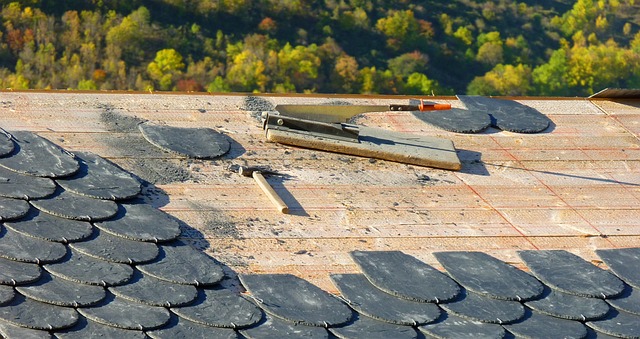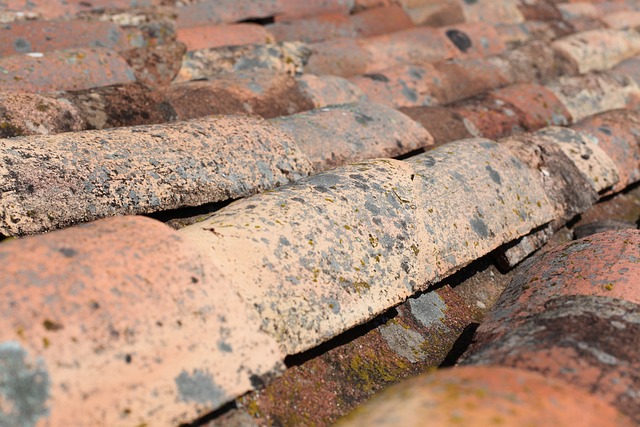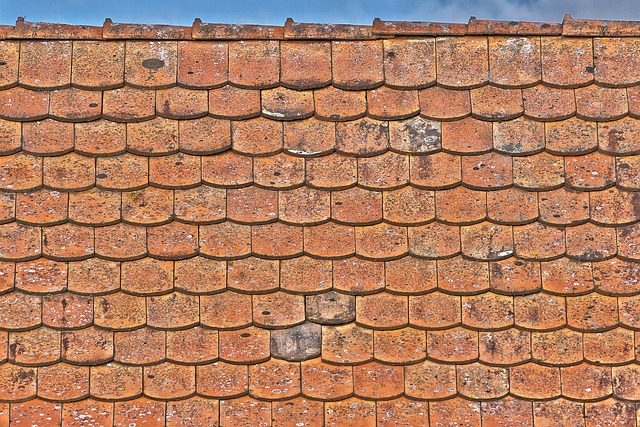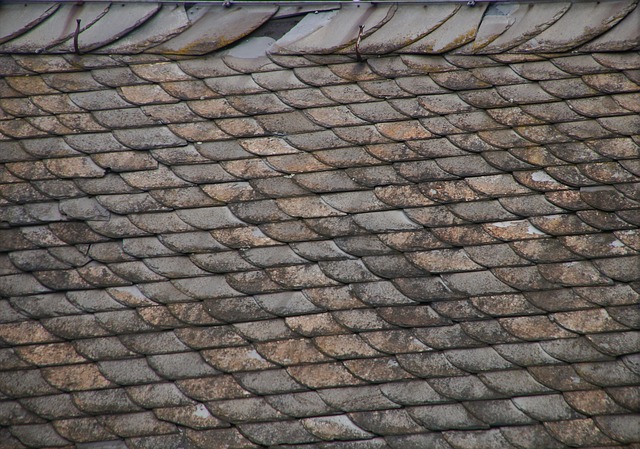Proper attic ventilation is essential for maintaining a roof's health, longevity, and structural integrity. A roofer evaluates the balance between intake (soffit vents) and exhaust (ridge vents) vents to ensure effective airflow that prevents condensation, mold growth, and wood rot, all while safeguarding occupant health. In warm climates, ventilation helps prevent attic overheating and its associated damage, while in cooler regions, it can prevent ice dams. A roofer can tailor solutions to improve ventilation, extending the roof's lifespan and boosting energy efficiency by moderating attic temperatures. Homeowners should consult with professional roofers to assess their attic's ventilation system for optimal performance and protection against thermal stress, which can lead to costly repairs or replacements. Additionally, proper ventilation is crucial in combating ice dam formation during winter, which can cause significant structural and mold damage. A roofer ensures a balanced airflow through the use of ridge and soffit vents, thus protecting the roof from heat-related damage and extending its lifespan in hot climates. Engaging a skilled roofer to install or repair an attic ventilation system is a key step in preserving your home's condition and promoting energy efficiency.
roof longevity, attic ventilation, professional roofer assessment, ventilation systems, ice dam prevention, roof system maintenance, attic insulation, energy efficiency, indoor air quality, seasonal maintenance.
When it comes to extending the life of your roof, proper attic ventilation is not just a recommendation—it’s a critical component for maintaining the integrity and functionality of your home’s uppermost layer. This article delves into the pivotal role that attic ventilation plays in preserving your roof system against the elements. From understanding its impact on roof longevity to exploring innovative solutions tailored for modern homes, we cover everything you need to know about attic ventilation. Whether you’re a homeowner seeking DIY tips or looking to engage a professional roofer for a comprehensive assessment, this guide will equip you with the knowledge to make informed decisions about your roof’s health and energy efficiency. Discover how optimizing your attic ventilation can lead to significant long-term benefits and enhance both the quality and comfort of your living space.
- Understanding Attic Ventilation and Its Impact on Roof Longevity
- The Role of a Professional Roofer in Assessing Attic Ventilation Needs
- Types of Attic Ventilation Systems: Soffit Vents, Ridge Vents, and Beyond
- How Proper Ventilation Prevents Ice Dams During Winter Months
- The Science Behind Attic Ventilation: Keeping Your Roof Cool in Summer
Understanding Attic Ventilation and Its Impact on Roof Longevity

Proper attic ventilation is a critical component in maintaining the integrity and longevity of a roof system. When a roofer assesses a structure, they examine the balance between intake vents at the soffit and exhaust vents near the ridge to ensure effective airflow. This balance is vital because it prevents condensation buildup that can lead to mold growth and wood rot, which are detrimental to both the structural integrity of the roof and the health of the building’s occupants. In warm climates, improper ventilation can cause the attic to reach extreme temperatures, baking the wooden supports until they weaken and potentially fail. Conversely, in cooler regions, insufficient ventilation can allow the attic to remain cold, leading to ice dam formation on roof edges during winter. These dams can prevent melting snow from draining properly, causing water to back up under shingles, which then seeps into the home and can cause significant damage over time. A roofer experienced in assessing and improving attic ventilation can provide solutions that extend the life of a roof significantly by ensuring that it is well-ventilated and dry. This not only protects against premature aging due to thermal expansion and contraction but also optimizes energy efficiency, as a balanced temperature within the attic space reduces the need for heating and cooling systems to work overtime. Thus, homeowners should consider engaging a professional roofer to evaluate their attic’s ventilation system and make necessary improvements, thereby safeguarding one of their home’s most important structural elements.
The Role of a Professional Roofer in Assessing Attic Ventilation Needs

When it comes to assessing and addressing attic ventilation needs, the expertise of a professional roofer is invaluable. These specialists possess the knowledge and skills necessary to evaluate your attic’s current ventilation system and determine if it meets the standards required for optimal roof performance. They understand the interplay between different ventilation types—such as intake vents, ridge vents, soffit vents, and gable vents—and how they work in concert to regulate attic temperature and humidity levels. A professional roofer can identify potential issues like poor insulation, blocked vents, or improperly designed ventilation systems that could lead to premature aging of the roof structure.
The role of a professional roofer extends beyond mere diagnosis; they also offer tailored solutions to enhance attic ventilation. They can recommend and install additional or alternative vents, relocate existing ones for better performance, or design an entirely new system that complements your home’s architecture and environmental conditions. By engaging a skilled roofer, homeowners can ensure that their attic is adequately ventilated, thereby extending the life of their roof system and safeguarding their home against the adverse effects of moisture and heat buildup. This proactive approach not only preserves the structural integrity of the roof but also contributes to energy efficiency and cost savings over time.
Types of Attic Ventilation Systems: Soffit Vents, Ridge Vents, and Beyond

Roof systems are critical components of a home’s structure, and their longevity is often contingent upon proper attic ventilation. This not only ensures comfort within the living spaces but also prevents condensation and moisture build-up that can compromise the integrity of the roof over time. Among the various types of attic ventilation systems available, soffit vents, ridge vents, and beyond play pivotal roles in maintaining a balanced airflow.
Soffit vents are typically installed along the eaves of a home and allow cool air to enter the attic space during the summer months. This air flow helps to push the hot air up and out through other ventilation points, such as ridge or gable vents. Roofers emphasize that soffit vents are essential for preventing stagnant air pockets that can cause excessive heat and humidity within the attic, leading to premature aging of the roof materials. On the contrary, ridge vents are installed along the peak of the roof and serve as the primary outlet for hot air to escape. They are designed to be continuous across the length of the roof, providing an unobstructed path for heat to dissipate. This design is highly effective in expelling warm air year-round, which is crucial for maintaining a stable attic temperature. Additionally, beyond these common types, there are other ventilation solutions like gable vents, turbine vents, and powered attic ventilators that can be tailored to the specific needs of different roofing systems by skilled roofers. Each of these options contributes to an overall ventilation strategy that can extend the life of your roof system by protecting it from the damaging effects of moisture and extreme temperatures.
How Proper Ventilation Prevents Ice Dams During Winter Months

Proper attic ventilation plays a pivotal role in preventing ice dams during the harsh winter months. As snow melts on a roof, it can re-freeze at the eaves or gutters, forming dangerous ice dams. These dams occur when warm air from the living space escapes into the attic, causing the snow on the roof to melt and then refreeze at the lower edges where it’s colder. This cycle can lead to water backing up under the shingles, which can seep into the home, cause structural damage, or lead to mold growth. A roofer will attest that a well-ventilated attic helps maintain a balance between the temperatures in the attic and the outside air, ensuring that the snow on the roof remains frozen and does not turn into liquid water that can refreeze as an ice dam. This ventilation allows for adequate air circulation, which prevents the buildup of warm air within the attic space, thus mitigating the formation of ice dams. Installing ridge vents and soffit vents are effective strategies recommended by roofers to facilitate this natural airflow. By doing so, homeowners can protect their roof systems from the damages associated with ice dams, ultimately extending the lifespan of their roofs and saving on costly repairs.
The Science Behind Attic Ventilation: Keeping Your Roof Cool in Summer

Attic ventilation plays a pivotal role in maintaining the integrity and longevity of a roof system, particularly during the scorching summer months. Proper attic ventilation ensures that the hot air within the attic is expelled, allowing cooler air to enter. This temperature differential is crucial in preventing the roof from overheating, which can lead to premature aging and material degradation. The science behind this phenomenon is rooted in the principles of thermodynamics. As ambient temperatures rise outside, without adequate ventilation, an attic can become a superheated chamber. This intense heat cooks the underside of the roof sheathing, leading to shingle warping and detachment, as well as structural damage to the roof’s framing. A skilled roofer understands this process and will recommend and install a balanced ventilation system, which typically consists of intake vents near the soffit and exhaust vents near the ridge. This design allows for a continuous flow of air through the attic space, effectively maintaining a cooler temperature within. Consequently, the roof materials remain stable, extending their lifespan and ensuring the protection of the building’s contents and inhabitants from the effects of solar radiation.
Effective attic ventilation plays a pivotal role in maintaining the integrity and longevity of your roof system. As explored, it safeguards against overheating in summer and ice dam formation in winter, thereby extending the life of your roof. When considering the importance of attic ventilation, engaging a proficient roofer becomes imperative to tailor a solution that fits your specific needs. Whether you opt for soffit vents or ridge vents, understanding the options available and their benefits is key. Investing in proper attic ventilation not only enhances comfort but also protects one of your home’s most critical components. Homeowners are encouraged to prioritize this aspect of roof maintenance to enjoy a durable and functional roof system for years to come.



